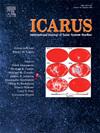17种模拟月球风化层的三维形状和尺寸分布测量:模拟月球风化层的形状和尺寸对比以及与阿波罗11号和阿波罗14号月球风化层的模拟形状对比
IF 2.5
2区 物理与天体物理
Q2 ASTRONOMY & ASTROPHYSICS
引用次数: 0
摘要
与真正的月球风化层材料相比,制造月球风化层模拟物是为了提供更大的体积、更便宜、更容易获得的材料来源,用来测试设计用于在月球表面运行的各种仪器和机器。这些材料的粒度分布和矿物学是工程设计的,而不是颗粒形状,尽管颗粒形状在许多工程应用中起着重要作用。因此,这些材料的三维(3D)形状很少被表征,也从未相互比较过,也从未与真正的月球风化层材料进行过比较。本文的重点是提供17种不同模拟材料的三维形状和尺寸分布,使用这些数据将这些材料相互比较,并将这些数据提供给NIST数据库。这个数据库中有超过1.1 M个粒子,它们的3D形状以STL文件的形式存储。考虑的粒径范围大致为7 μm至1mm。随着最近公布的阿波罗11号和阿波罗14号任务月球风化层材料的三维特征,这些特征也与真实月球风化层材料的等效数据进行了比较。使用图形比较以及大小和形状的优点分析来研究母马和高地模拟。这种3D表征提供了新的工程制造技术将需要的信息,以实现新的月球风化模拟物的颗粒形状工程,因为能够进行与制造和使用相关的颗粒形状测量是任何此类工程的先决条件。该数据库还可以作为“数字双胞胎”或“虚拟模拟”的来源,用于单个粒子特性和填充粒子几何形状和特性的建模研究。本文章由计算机程序翻译,如有差异,请以英文原文为准。
Measurement of the three-dimensional shape and size distribution of 17 lunar regolith simulants: Simulant shape and size inter-comparison and simulant shape comparison with Apollo 11 and Apollo 14 lunar regolith
Lunar regolith simulants are manufactured in order to provide a higher volume, much less expensive and more available source of material, compared to real lunar regolith material, with which to test various instruments and machines designed to operate on the lunar surface. The particle size distribution and mineralogy of these materials is engineered but not the particle shape, although particle shape does play an important role in many engineering applications. Thus, the three-dimensional (3D) shape of these materials has rarely been characterized and never compared to each other and to real lunar regolith material. The focus of this paper is to provide 3D shape and size distribution of 17 different simulants, use this data to compare these materials against each other and provide these data in a NIST database. Over 1.1 M particles are in this database, with their 3D shape stored as STL files. The particle size range considered is roughly 7 μm to 1 mm. With the recent publication of 3D characterizations of lunar regolith material from the Apollo 11 and Apollo 14 missions, these characterizations are also compared to equivalent data for the real lunar regolith material. Both mare and highland simulants are studied using graphical comparisons as well as size and shape figure of merit analysis. This kind of 3D characterization provides the information that new engineering manufacturing techniques will need to enable the engineering of particle shape for new lunar regolith simulants, since the ability to make particle shape measurements relevant to manufacturing and use is a prerequisite for any such engineering. This database can also serve as a source of “digital twins” or “virtual simulants” for modeling studies both of individual particle properties and of packed particle geometry and properties.
求助全文
通过发布文献求助,成功后即可免费获取论文全文。
去求助
来源期刊

Icarus
地学天文-天文与天体物理
CiteScore
6.30
自引率
18.80%
发文量
356
审稿时长
2-4 weeks
期刊介绍:
Icarus is devoted to the publication of original contributions in the field of Solar System studies. Manuscripts reporting the results of new research - observational, experimental, or theoretical - concerning the astronomy, geology, meteorology, physics, chemistry, biology, and other scientific aspects of our Solar System or extrasolar systems are welcome. The journal generally does not publish papers devoted exclusively to the Sun, the Earth, celestial mechanics, meteoritics, or astrophysics. Icarus does not publish papers that provide "improved" versions of Bode''s law, or other numerical relations, without a sound physical basis. Icarus does not publish meeting announcements or general notices. Reviews, historical papers, and manuscripts describing spacecraft instrumentation may be considered, but only with prior approval of the editor. An entire issue of the journal is occasionally devoted to a single subject, usually arising from a conference on the same topic. The language of publication is English. American or British usage is accepted, but not a mixture of these.
 求助内容:
求助内容: 应助结果提醒方式:
应助结果提醒方式:


